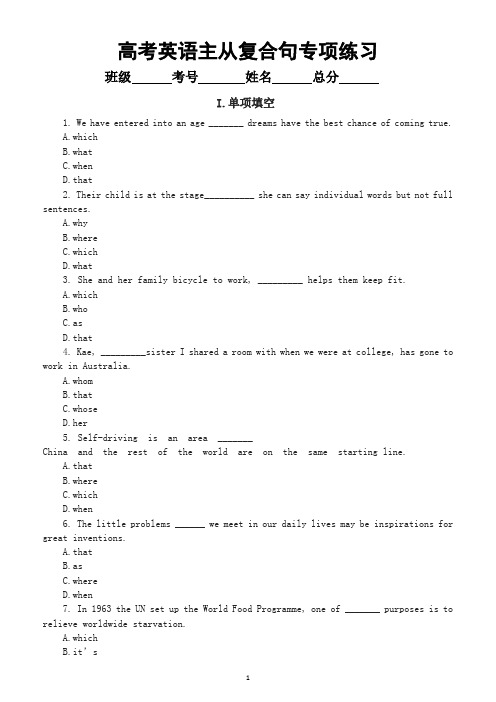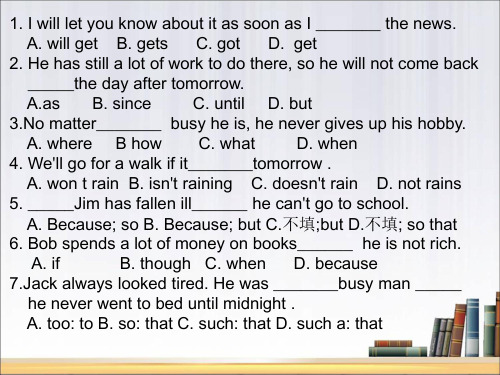主从复合句练习
2024年初一英语主从复合句类型练习题30题

2024年初一英语主从复合句类型练习题30题1.I don't know _____ he will come to the party.A.ifB.thatC.whenD.what答案:A。
本题考查宾语从句连接词。
“if”表示“是否”,在句中符合语境,不确定他是否会来参加派对。
“that”在宾语从句中无实际意义,此处不合适。
“when”表示“什么时候”,题干中没有明确关于时间的疑问。
“what”表示“什么”,不符合题意。
2.My mother asks me _____ I have finished my homework.A.ifB.thatC.whenD.what答案:A。
“if”在这里表示“是否”,妈妈问我是否完成了作业。
“that”无实际意义,这里不是陈述一个确定的事实。
“when”题干中没有关于时间的疑问。
“what”不符合题意。
3.We wonder _____ he is a good student.A.ifB.thatC.when答案:A。
“if”表示“是否”,我们想知道他是否是个好学生。
“that”不适合此语境,不是陈述确定事实。
“when”无时间疑问。
“what”不合适。
4.The teacher tells us _____ we should study hard.A.ifB.thatC.whenD.what答案:B。
这里“that”引导宾语从句,无实际意义,老师告诉我们我们应该努力学习,是陈述一个事实。
“if”“when”“what”均不符合题意。
5.I want to know _____ he likes English.A.ifB.thatC.whenD.what答案:A。
“if”表示“是否”,我想知道他是否喜欢英语。
“that”此处不合适,不是陈述事实。
“when”没有时间疑问。
“what”不符合题意。
6.Do you know _____ he will go to Beijing?A.ifB.thatD.what答案:A。
主从复合句结构练习50题

主从复合句结构练习50题1. I don't know ________ he will come tomorrow.A. thatB. ifC. whenD. where答案:B。
本题考查宾语从句的引导词。
选项A“that”在宾语从句中无实际意义,通常引导陈述句,此处从句有疑问含义,A 不正确。
选项B“if”表示“是否”,符合语境,不知道他明天是否会来,B 正确。
选项C“when”表示“什么时候”,与句意不符。
选项D“where”表示“哪里”,也不符合句意。
2. Can you tell me ________ you were born?A. whenB. whereC. whatD. which答案:A。
此题考查宾语从句引导词。
选项A“when”表示时间,询问出生的时间,符合题意,A 正确。
选项B“where”表示地点,出生的地点,与句子逻辑不符。
选项C“what”通常用于询问事物,在此处不合适。
选项D“which”表示“哪一个”,不符合句子意思。
3. He asked me ________ I could help him.A. thatB. whatC. ifD. how答案:C。
本题考查宾语从句引导词。
选项A“that”引导陈述句,此处有疑问,A 错误。
选项B“what”用于询问事物,不符合句意。
选项C“if”表示“是否”,他问我是否能帮助他,C 正确。
选项D“how”表示方式,在此不恰当。
4. Please tell me ________ you have seen the film.A. ifB. thatC. whenD. what答案:A。
此题考查宾语从句引导词。
选项A“if”表示“是否”,询问是否看过电影,A 正确。
选项B“that”引导陈述句,此处需要疑问词,B 不正确。
选项C“when”表示时间,与句意不符。
选项D“what”用于询问事物,不符合句子意思。
5. I want to know ________ he has been to Beijing.A. ifB. whenC. thatD. where答案:A。
高中英语高考复习主从复合句专项练习(附参考答案)

高考英语主从复合句专项练习班级考号姓名总分I.单项填空1. We have entered into an age _______ dreams have the best chance of coming true.A.whichB.whatC.whenD.that2. Their child is at the stage__________ she can say individual words but not full sentences.A.whyB.whereC.whichD.what3. She and her family bicycle to work, _________ helps them keep fit.A.whichB.whoC.asD.that4. Kae, _________sister I shared a room with when we were at college, has gone to work in Australia.A.whomB.thatC.whoseD.her5. Self-driving is an area _______China and the rest of the world are on the same starting line.A.thatB.whereC.whichD.when6. The little problems ______ we meet in our daily lives may be inspirations for great inventions.A.thatB.asC.whereD.when7. In 1963 the UN set up the World Food Programme, one of _______ purposes is to relieve worldwide starvation.A.whichB.it’sC.whoseD.whom8. My eldest son, _______ work takes him all over the world, is in New York at the moment.A.thatB.whoseC.hisD.who10. I live next door to a couple ________ children often make a lot of noise.A.whoseB.whyC.whereD.which11. Many young people, most ______were well-educated, headed for remote regions to chase their dreams.A.of whichB.of themC.of whomD.of those12. We will put off the picnic in the park until next week, ____ the weather may be better.A.thatB.whereC.whichD.when13. Scientists have advanced many theories about why human beings cry tears , none of ______ has been proveD.A.whomB.whichC.whatD.that14. It is a truly delightful place, ________ looks the same as it must have done 100 years ago with its winding streets and pretty cottages..A.asB.whereC.thatD.which15. Opposite is St.Paul's Church,___you can hear some lovely musiC.A.whichB.thatC.whenD.where16. He wrote many children’ s books, nearly half of____ were published in the 1990s.A.whomB.whichC.themD.that17. Creating an atmosphere employees feel part of a team is a big challenge.A.asB.whoseC.in whichD.at which18. The boss of the company is trying to create an easy atmosphere ______ his employees enjoy their work.A.whereB.whichC.whenD.who19. The books on the desk, covers are shiny, are prizes for us.A.whichB.whatC.whoseD.that20. As the smallest child of his family, Alex is always longing for thetime he should be able to be independent.A.whichB.whereC.whomD.whenII.语法填空1. Now Irene Astbury works from 9am to 5pm daily at the pet shop in Macclesfield,___62___ she opened with her late husband Les.2. They were well trained by their masters ___64___ had great experience with caring for these animals.3. On the edge of the jacket, there is a piece of cloth ___58___gives off light in the dark.4. The students benefitting most from college are those ___9___ are totally engaged(参与)in academic life.5. Two of the authors of the review also made a study published in 2014___66___showeda mere five to 10 minutes a day of running reduced the risk of heart disease and early deaths from all causes.6. The Chinese Ministry of Agriculture finds that between 2005—when the government started a soil-testing program ___69___ gives specific fertilizer recommendations to farmers - and 2011, fertilizer use dropped by7.7 million tons.7. Many westerners ___57___ come to China cook much less than in their own countries once they realize how cheap it can be to eat out.8. Like anything, it is possible to have too much of both, 70.________ is not good for the health.9. But Sarah, 64.________ has taken part in shows along with top models, wants to prove that she has brains as well as beauty.10. Pahlsson and her husband now think the ring probably got swept into a pile of kitchen rubbish and was spread over the garden, 64.________ it remained until the carrot's leafy top accidentally sprouted (生长) through it.11.阅读下面材料,在空白处填入适当的内容(1个单词)或括号内单词的正确形式。
主从复合句专项练习题

主从复合句专项练习题一、选择题1、 I don't know ______ he will come tomorrow ______ he comes,I'll tell youA if; WhetherB whether; WhetherC if; ThatD if; If答案:D解析:第一句“我不知道他明天是否会来”,if 和whether 都有“是否”的意思,但在宾语从句中,两者都可以使用。
第二句“如果他来,我会告诉你”,if 表示“如果”,引导条件状语从句。
2、 I don't know the reason ______ he was late for the classA whyB whenC thatD which答案:A解析:“the reason why”是一个常用句型,表示“的原因”,why 在从句中作原因状语。
3、 This is the school ______ I studied three years agoA whereB whenC thatD which答案:A解析:先行词是“the school”,在从句“ I studied three years ago”中作地点状语,所以用 where。
4、 The man ______ is talking to our teacher is Betty's fatherA whichB whomC whoD what答案:C解析:先行词“the man”指人,且在从句中作主语,所以用 who。
5、 The book ______ I bought yesterday is very interestingA thatB whichC whoD whose答案:A/B解析:先行词“the book”指物,在从句中作宾语,that 和 which 都可以引导定语从句并作宾语。
6、 I'll never forget the days ______ we spent togetherA whenB thatC on whichD in which答案:B解析:先行词“the days”在从句“we spent together”中作宾语,所以用that 。
初一英语主从复合句类型练习题30题

初一英语主从复合句类型练习题30题1.I think he will come to my birthday party.(改为宾语从句)I think _that_ he will come to my birthday party.答案:that。
本题考查宾语从句的引导词。
在这个句子中,“he will come to my birthday party”是完整的陈述句,所以用引导词that。
2.My mother asks me _if/whether_ I have finished my homework.答案:if/whether。
本题考查宾语从句的引导词。
“I have finished my homework”是一般疑问句,所以用引导词if/whether。
3.I don't know _what_ he is doing now.答案:what。
本题考查宾语从句的引导词。
“he is doing now”缺少宾语,所以用引导词what。
4.Can you tell me _how_ I can get to the library?答案:how。
本题考查宾语从句的引导词。
“I can get to the library”缺少方式状语,所以用引导词how。
5.She wonders _when_ the class will start.答案:when。
本题考查宾语从句的引导词。
“the class will start”缺少时间状语,所以用引导词when。
6.We are discussing _where_ we should go for the picnic.答案:where。
本题考查宾语从句的引导词。
“we should go for the picnic”缺少地点状语,所以用引导词where。
7.I want to know _who_ is your best friend.答案:who。
主从复合句练习

C.what was the matter with him D what the matter was with him
23.---Did you know_______yesterday?
---No, I didn't know the reason.
A. how he arrived
B what he did
28.---Could you tell me_________ travelling this summer?
---We plan to go and see the beautiful sea in Sanya.
A. where your family will go B.how will your family go
A. too: to B. so: that C. such: that D. such a: that
8. If he______ harder next time, he will catch up with us.
A. work B. worked C. works D. will work
19.---Where does he come from?
---Pardon?
---I asked where______
A. did he come from B. he came from
C. he come from D. does he come from
20. ______you told me, I had heard nothing of what happened .
D. where John is going
19. ---I wonder________?
语法精讲主从复合句练习题及

语法精讲主从复合句练习题及答案主从复合句是由一个主句和一个或多个从句组成的复合句结构。
在主从复合句中,主句起主导作用,而从句则充当主句的附属成分,起到补充、解释、强调或修饰的作用。
掌握主从复合句的语法结构和用法对于提高写作能力和语言表达的准确性非常重要。
下面是一些主从复合句的练习题供你参考:练习一:选择正确的从属连词完成下面的句子。
1. I will go to the library _____ I finish my work. (after, before)2. She didn't answer the phone _____ she was busy. (while, because)3. We should go now _____ it starts raining. (when, unless)4. _____ she studies hard, she won't pass the exam. (Although, If)5. He couldn't sleep _____ it was too noisy. (because, unless)练习二:将下面的简单句改写成主从复合句。
1. I will come to the party. I finish my work. (When)2. She didn't buy the dress. She didn't like the color. (Because)3. They will miss the train. They don't leave now. (Unless)4. Tom won't pass the test. He doesn't study hard. (If)5. He can't go to the concert. He has a meeting. (Although)练习三:根据提示写出合适的主从复合句。
七年级英语主从复合句引导词练习题30题

七年级英语主从复合句引导词练习题30题1.I usually do my homework after school ____ I finish playing basketball.A.whenB.beforeC.afterD.until答案:A。
本题考查时间状语从句引导词。
“when”表示“当……的时候”,符合题意。
“before”表示“在……之前”,与题干逻辑不符。
“after”表示“在……之后”,题干中是先打篮球后做作业,与顺序不符。
“until”表示“直到……才”,也不符合题干意思。
2.I get up early in the morning ____ I can catch the school bus.A.so thatB.as soon asC.whileD.since答案:A。
“so that”表示“以便,为了”,符合语境,早起是为了赶上校车。
“as soon as”表示“一……就……”,不合适。
“while”表示“当……的时候”,不符合。
“since”表示“自从”,也不符合。
3.I start to study English ____ I come back from school.A.as soon asB.untilD.while答案:A。
“as soon as”表示“一……就……”,符合逻辑,从学校回来就开始学英语。
“until”表示“直到……才”,与题意不符。
“when”和“while”在此处不合适。
4.I finish my breakfast quickly ____ I won't be late for school.A.so thatB.beforeC.afterD.when答案:A。
“so that”表示目的“以便”,快速吃完早餐以便不迟到。
“before”“after”“when”都不能表达此目的。
5.I clean my room on weekends ____ I have free time.A.whenB.beforeC.afterD.until答案:A。
- 1、下载文档前请自行甄别文档内容的完整性,平台不提供额外的编辑、内容补充、找答案等附加服务。
- 2、"仅部分预览"的文档,不可在线预览部分如存在完整性等问题,可反馈申请退款(可完整预览的文档不适用该条件!)。
- 3、如文档侵犯您的权益,请联系客服反馈,我们会尽快为您处理(人工客服工作时间:9:00-18:30)。
主从复合句练习
一、单项填空
1.--- Do you know______ going to stay in London?
--- No, I don't. Maybe a few days.
A. when he is
B. how long he is
C. when is he
D. how long is he
3. I’m new here. Could you tell me ____, please?
A. where the first bus arrive
B. when the first bus arrives
C. when did the first bus arrive
D. when will the first bus arrive
5.Children like houses_____ are painted in different colours.
A. which
B. they
C. those
D. what
6.Miss Green is the only person ______ can help you with your English.
A. she
B. whom
C. which
D. who
7. I don’t know when he _______. When he ______. I will let you know.
A. will arrive; will arrive
B.arrives; arrives
C. will arrive ; arrives
D.arrives; will arrive
8.---Can you guess who will be the first to cross the finishing line?
--- Sandy. Jane didn’t run so fast _____ she did last time.
A. than
B. so
C. that
D. as
9.---Why hasn’t Mr.Li come to work today?
---________he has gone to Beijing to have a meeting.
A. If
B. Until
C. Though
D. Because
10. _______ they are twins, they don’t look the same at all.
A. Because
B. Though
C. As
D.Since
11.He is the most boring speaker ______ I have ever met.
A. that
B. whose
C. which
D. as
12.---Tell him to come to see me, will you?
--- Sure, I’ll let him know as soon as he______
A.return
B. returns
C. will return
D.returned
13. Anyone ____ has a question please come here.
A. who
B.which
C. whose
D. that
二、句型转换
1.“Do they want fried chicken?”He asked the boys. (改为含宾语从句
的复合句)
He asked the boys _____ they _____ fried chicken.
2.Water the young plants often, or they will die.(改为含有状语从句的复
合句)
_______ _______ ______ water the young plants often, they will die. 3.“ How much water is there in the bottle?” Our teacher asked.(改为宾语
从句)
Our teacher asked ______ _______ water there _______ in the bottle. 4.My mother didn’t decide where we would go for a holiday.(改为简单句)
My mother didn’t decide ________ ________ go for a holiday.
5.I like Chinese tea without anything in it. (改为定语从句)
I like Chinese tea _______ _______ _______ in it.。
